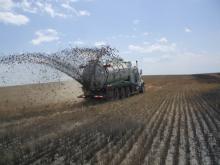Data provider
Budapest University of Technology and Economics, Department of Applied Biotechnology and Food Science, Environmental Microbiology and Biotechnology Group
Contact details
Compulsory sheet of the technology
Financing of the project
Application sphere
- 13 OIL WASTES AND WASTES OF LIQUID FUELS (except edible oils, and those in chapters 05, 12 and 19)
- 13 07 wastes of liquid fuels
- 13 07 03* other fuels (including mixtures)
Description of environmental risk
fémszennyezettség
szervetlen vegyületek
Information on the technology
A talajban a fúrási hulladékok alkalmazásának célja, hogy a talaj természetes mikrobiális populációi bontsák, átalakítsák, és asszimilálni tudják a hulladékok összetevőit a bejuttatási helyen.
Az olajtartalmú hulladék környezetre nem károsan, és alkalmanként környezet számára hatékonyan felhasználható.
Technology classification
- Biological technologies
- Injection into soil
Technology-monitoring
Costs of the technology
SWOT (evalaution based on scores)
SWOT (evaluation in words)
Környezetbarát
Költséghatékony
Enargiatékéros
Újrahasznosítás
Időigényes
Folyamatos megfigyelést igényel
Sok előkészületet igényel
Nagy földterületet igényel
Talajspecifitás
Környezetszennyezés csökkentése
Használhatatlanná vált földterületek remediációja
Mikroorganizmusok számára káros lehet
Növényzetre káros lehet
Talajszáradást okozhat
Completed applications
- 13 OIL WASTES AND WASTES OF LIQUID FUELS (except edible oils, and those in chapters 05, 12 and 19)
- 13 07 wastes of liquid fuels
- 13 07 03* other fuels (including mixtures)
Publications, references
Bansal, K.M., and Sugiarto, 1999, 'Exploration and Production Operations - Waste Management A Comparative Overview: U.S. and Indonesia Cases,' SPE 54345, SPE Asia Pacific Oil and Gas Conference, Jakarta, Indonesia, April 20-22.
Callahan, M.A., A.J. Stewart, C. Alarcon, and S.J. McMillen, 2002, 'Effects of Earthworm (Eisenia Fetida) and Wheat (Triticum Aestivum) Straw Additions on Selected Properties of Petroleum-Contaminated Soils,' Environmental Toxicology and Chemistry, Vol. 21, No. 8, pp. 1658-1663.
Cole, E., and S. Mark, 2000, 'E&P Waste: Manage It Cost Effectively through Land Farming,' World Oil, August Vol. 221, No. 8 (Available at: http://www.worldoil.com/magazine/magazine_detail.asp?ART_ID=1145 EandP.)
E&P Forum, 1993, 'Exploration and Production (E&P) Waste Management Guidelines,' Report No. 2.58/196, September.
Morillon, A., J.F. Vidalie, U.S. Hamzah, S. Suripno, and E.K. Hadinoto, 2002, 'Drilling and Waste Management', SPE 73931, presented at the SPE International Conference on Health, Safety, and the Environment in Oil and Gas Exploration and Production, March 20-22.
Smith, M., A. Manning, and M. Lang, 1999, 'Research on the Re-use of Drill Cuttings Onshore,' November 11 (Available at: http://www.bmtcordah.com/_downloads/Re-use%20of%20Drill%20Cuttings%20On….)
